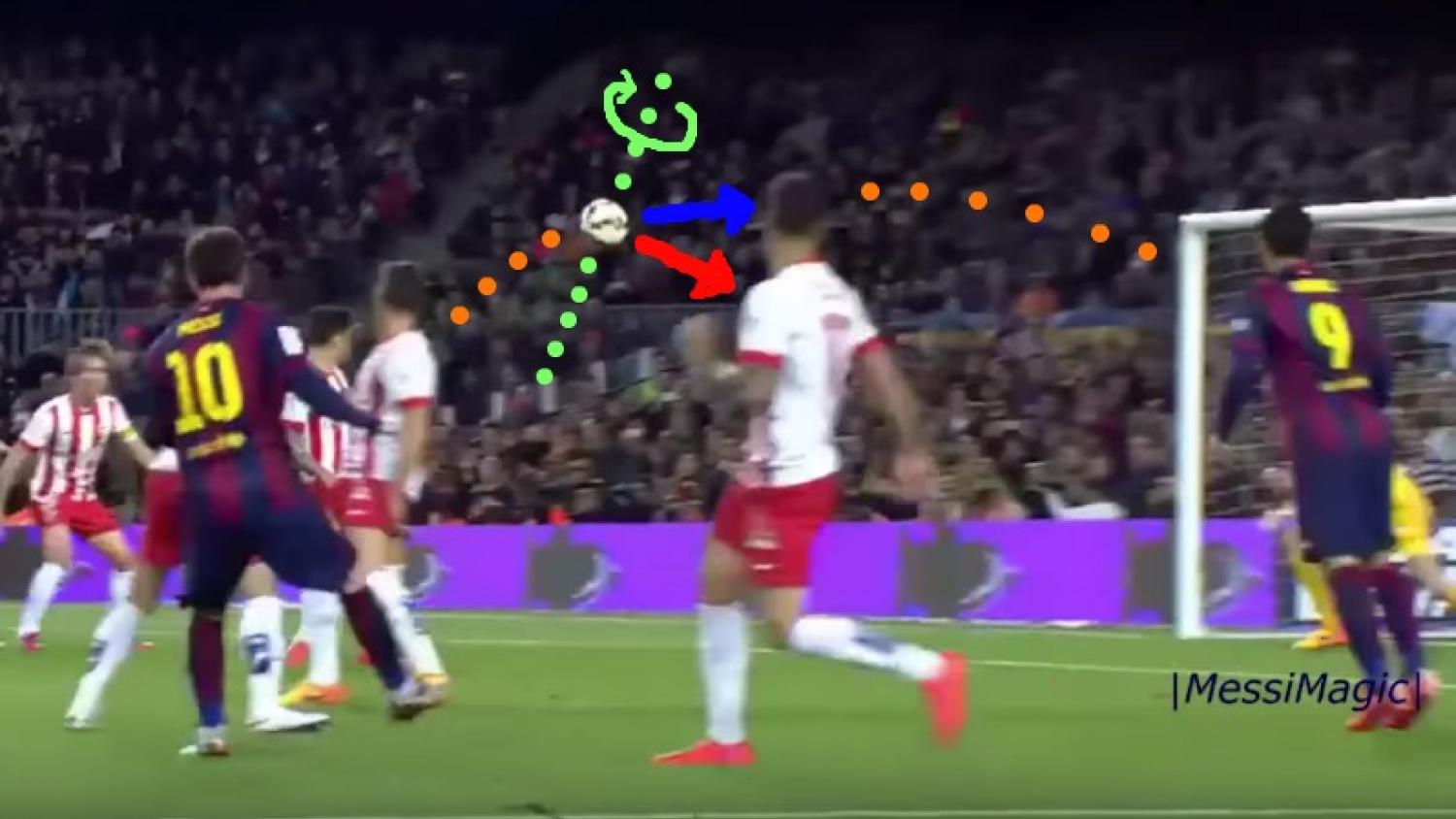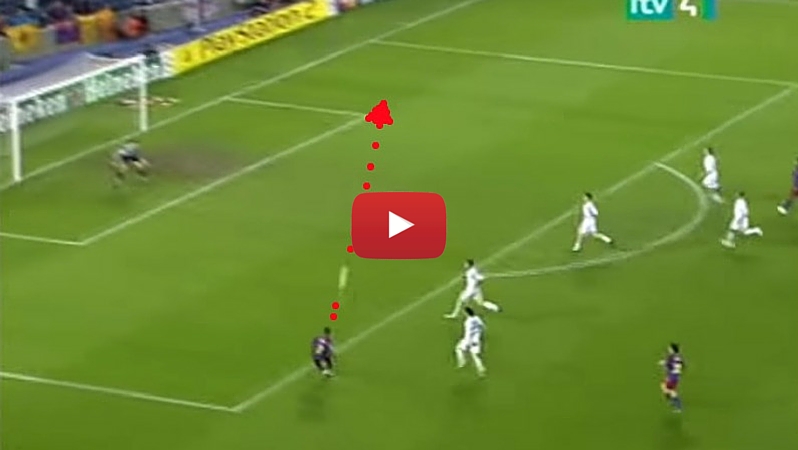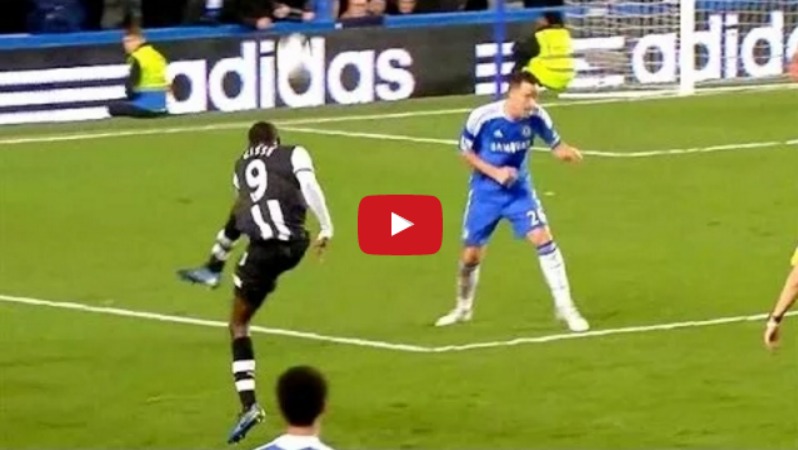Messi cannot break the laws of physics. As much as some of his fans love to say that he does, and as magical as his talent may seem, it is physically impossible for him to break the laws of physics. It is impossible for all of us, independent of some sort of incredible technology, to break the laws of physics. With a ball at his feet, Messi must obey the same laws as everyone else in the world. He just happens to be the best in the world at pushing those laws to their very limits. He can put the ball wherever he wants, curve it however he wants, but how does he do it? It can’t be magic, so how does a ball curve in the air?
Sir Arthur C. Clarke – a British author and inventor – once said, “Any sufficiently advanced technology is indistinguishable from magic.” So, before we break the spell of Messi’s magic by explaining the physics (a.k.a. “technology”) behind his insane curved goals, we’ll let you revel in them one last time. Behold:
Some say that the mark of a truly great player is their ability to control the ball and not be controlled by it. “The ball control me?” you might say. “Preposterous!” But that is exactly what happens when we take a bad touch and react to it, or slow down while sprinting with the ball at our feet so we don’t lose it. Messi rarely suffers either of those clear indications of a lack of control. He is always in control, and the realm of Messi’s control extends into the sky.
“They sky?!?” you say. “How can Messi control the ball when it is in the sky!? He cannot fly, he cannot follow the ball through the air after he has kicked it! How could he possible control the ball as it travels through the air?”
The answer to that is quite simple, and many of you have probably already said it out loud or thought it to yourself: it’s spin. Messi can control the ball while it is in the air because of the spin he puts on the ball. If you have played soccer, this is no surprise to you. But have you ever wondered how putting spin on the ball actually makes the ball curve in the air?
It’s a fascinating thing to think about. Watching Messi’s best curved goals, the ball clearly begins its flight traveling in one direction, then curves and changes direction, and ends up traveling in a completely different direction. It’s as if something moved the ball while it was in the air, which is confusing, to say the least.
In order for something to move, it must be pushed or pulled. It must feel a force. But how can something be pushed or pulled while it is moving through the air? Furthermore, how could the spin of the ball push or pull on the ball itself? How can anything push or pull on itself?
Try this: stand up, put your hand on your chest, and using your hand try to push yourself over. You can’t. It’s impossible. The laws of physics say it is impossible: a body cannot exert a force on itself.
So it seems that if the spin on the ball does cause it to push or pull itself, well, then I was wrong before: the ball is breaking the laws physics, and Messi is clearly a master of making it doing so.
So how do we solve this seemingly impossible problem? How do we explain how a ball’s own spin can cause it to change direction as it moves through the air? The answer is literally right in front of us: it’s the air that pushes and pulls the ball. More specifically, the spin of the ball makes the air push and pull on the ball, which forces the ball to curve in the air.
It all starts with drag. Drag, simply speaking, is friction with the air. We all know what friction is. When we pick things up with our hands, friction is what prevents it from slipping in our grip. We feel friction when we slide our feet across the floor. Drag resists motion through the air just like friction resists motion, but a very important difference is that drag resists an object more and more the faster that object moves through the air.
Imagine you are running outside and a gust of wind hits you in the face. That feeling of being slowed down by the wind is due to drag. It’s more noticeable when there is a gust of wind, but drag is there anytime we move, because air is everywhere around us (hopefully, shout out to deep sea divers). The faster we move, or the harder the wind blows at us, the more drag exerts a force on us. The same thing applies to a ball moving through the air.
Now, there is a special kind of drag called skin friction that we have to understand to answer the question: how does a ball curve in the air? Skin friction is the drag felt by an object along its sides. Remember that gust of wind that hit you? Most of the force you felt hit you in the face, across your chest and stomach and the front of your body. But the gust of wind also produced a little force as it passed across the sides of your head, of your arms, of your chest and of your legs. That force was the air dragging against the sides of your body. That drag along the sides is called skin friction, and it is what allows spin to change the direction of a ball.
To explain: When a ball flies through the air, the air doesn’t just exert a force on the ball because of drag, the ball also exerts a force on the air because of drag. This is a basic law of nature – every action has an equal and opposite reaction – that often has very serious and complicated consequences. What is important to understand here is that when a ball travels through the air, it interacts with and moves the air around it.
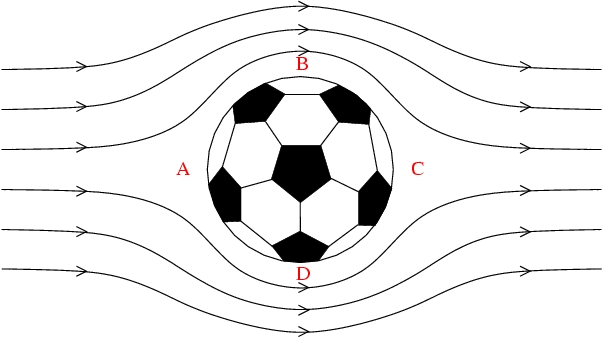
Photo: physics.hku.hk
In the diagram above the flow of air is represented by thin black lines. As you can see, the air split by the ball as it flies through the air to the left. As the split air passes across the ball, skin friction will drag against the sides of the ball (at the locations of B and D in the diagram above). And because every action has an equal an opposite reaction, the air closest to the ball will actually slow down as it drags against the sides of the ball at (B an D).
Now, when a ball is spinning, the amount of skin friction felt on either side of the ball (at either B or D) is not the same. Depending on which direction the ball is spinning and the direction in which the ball is moving, one side will feel more drag and the other will feel less.
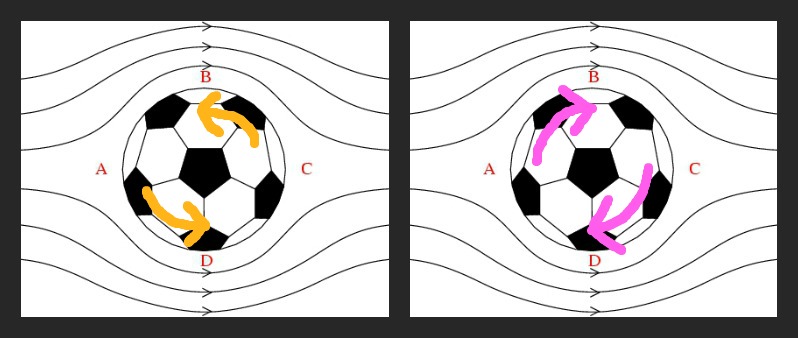
The ball is flying to the left through the air, and the air is flowing across the ball to the right. When the ball is spinning counter-clockwise (see the ball with the orange arrows in the diagram above) the upper side (B) moves against the flow of air and the lower side (D) moves with the flow of air. When the ball spins clockwise (see the ball with the purple arrows) the opposite is true: the upper side of the ball (B) moves with the flow of air, and the lower side (D) moves against the flow of air. In both cases, whichever side is moving with the flow of air as the ball spins will feel less skin friction than the side moving against the flow of air.
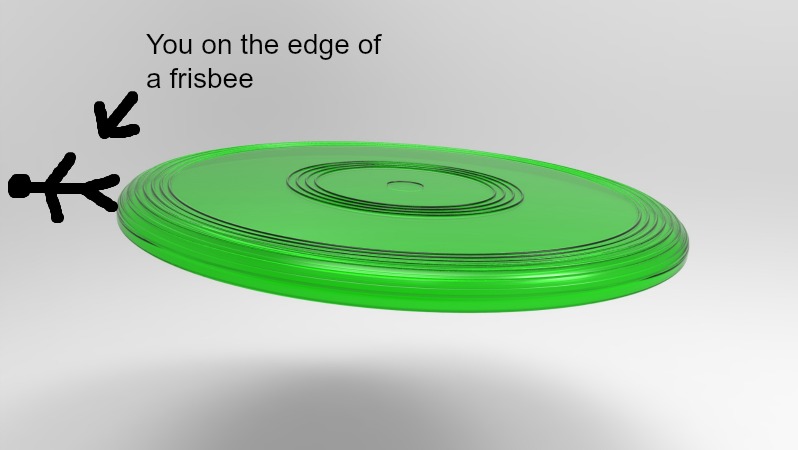
Gotta love stick people. Photo: moviespix.com
If this isn’t making sense, imagine you are standing on the edge of a frisbee flying through the air. Around and around you go, but the frisbee always goes in one direction. As you stand on there on the edge, you spin towards the direction the frisbee is flying, towards the flow of air, and then away from it. Towards and then away, towards and then away, as the frisbee spins and flies. When you move away from the direction the frisbee is flying, you move with the flow of air, so you don’t feel the wind as much and when you are moving towards the direction of flight and against the flow of air. The difference in the force you feel on either side is similar to the difference in skin friction felt on either side of a soccer ball as it spins through the air.
We are about to tie all of this together, so let’s go over all of what we have learned.
How Does A Ball Curve In The Air? Key Facts:
- Skin friction (which is a kind of drag) exerts a force on the sides of a ball as it flies through the air.
- When a ball spins, one of its sides experiences more skin friction than the opposite side.
- Every action has an equal and opposite reaction.
Yes, we just summarized everything we have discussed so far into three sentences. We are now ready to learn really what makes a spinning ball curve in the air.
The difference in skin friction on the sides of a spinning ball means that the air is exerting more force on one side of the ball and less on the other. And because every action has an equal and opposite reaction, one side of the ball exerts more force on the air than the other of the ball. Put simply, the sides of the ball drag on the air unequally. This makes the air on one side of the ball (spinning towards the direction of flight) move slower than the air on the opposite side.
The difference in the speed of air on either side of the ball leads to a difference in pressure on either side of the ball. This is because of Bernoulli’s principle, which states that when the speed of air decreases, the pressure of air increases (read more about Bernoulli’s principle here). So, on whichever side of the ball the air is moving slower, the air is increased in pressure.
Bernoulli’s principle also states that when the speed of air increases, pressure decreases. So, on the side of the ball the that the air is moving faster (because that side is spinning away from the direction the ball is flying, with the flow of air) the air is decreased in pressure.
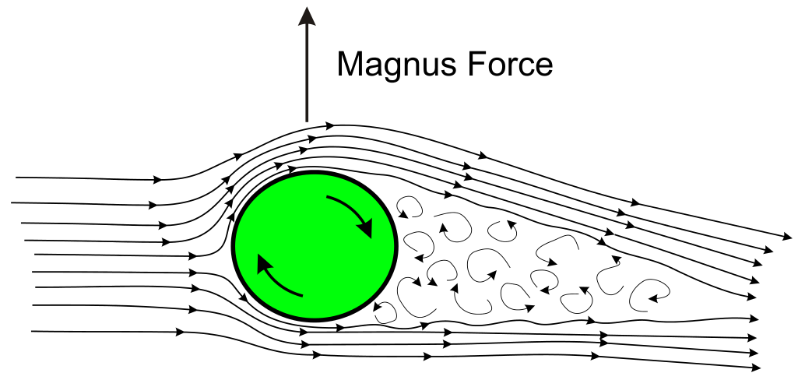
Photo: bluebird-electric.net
This difference in air pressure on either side of the ball is called the Magnus effect, and it moves the ball in the air with a force called the Magnus force. The Magnus force pushes the ball away from the high pressure air on one side of the ball and sucks it towards the low pressure air on the other. So how does a ball curve in the air? With the Magnus force caused by the Magnus effect, which is a difference in air pressure on either side of the ball.
Whether a ball curves left, right, up or down depends on how the ball is spun. In the below demonstration, the ball is spun back towards the person who releases it. Watch as the Magnus force pushes the ball away from the higher pressure side and sucks it towards the lower pressure side.
As the spinning ball falls downward, the Magnus force takes effect. The air on the side of the ball opposite the thrower (labelled B) decreases in pressure because that side of the ball is spinning with the flow of air, away from the direction of the ball’s fall. The air on the side of the ball closer to the thrower (labelled D) increases in pressure because that side of the ball is spinning against the flow of air on that side, and towards the direction of the ball’s fall. The Magnus effect pushes to ball towards the low pressure side, B.
Now You Know The Science. Try It Yourself!
In simple terms, the ball will always curve towards the direction it is spinning. Want to curve the ball right? Wrap your foot around the lower left side so that the ball spins clockwise (when looking down at it). Want to curve the ball left? Do the opposite.

Photo: screenshot
In Messi’s best curved goals — in all of Messi’s curved goals, for that matter — this same Magnus effect is present. The spin of the ball deceases pressure on one side of the ball and increases it on the other, and the resulting difference in pressure exerts the Magnus force which moves the ball so it curves through the air.
Espanyol recently experienced Messi’s mastery of the Magnus effect and the Magnus force the hard way when Messi scored one of the best free kicks of the season.
When they broke down how Messi scored that goal, I doubt they ended up with a picture that looked like this:
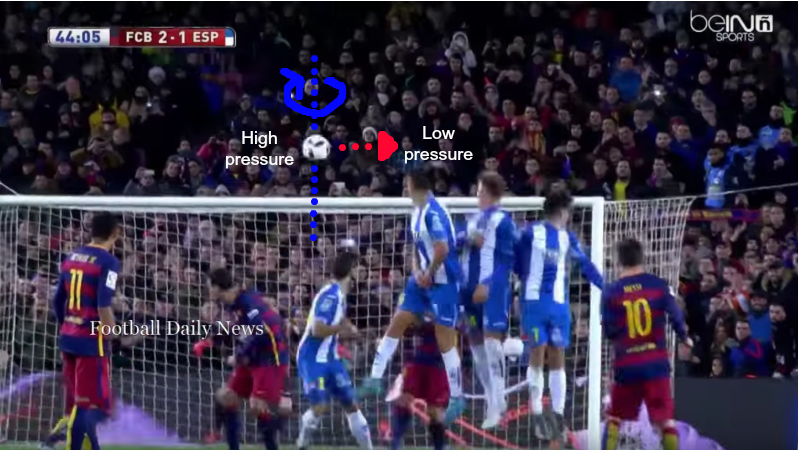
Photo: YouTube
And perhaps that was for the best, because the genius of Messi goes so far beyond his ability to make the ball curve in the air.
Related: Samuel Eto'o Scored The Best Curved Goal Of All Time
Related: Watch 6 Minutes Of Insane Curved Goals Ever
Follow me on Twitter: @yetly


